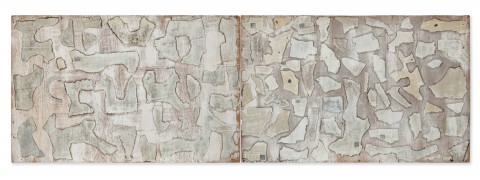SHEEP WEATHER ALERT 5, 1992 – 93
ROSALIE GASCOIGNE
torn and cut bitumen-based printed linoleum, paint and weathered plywood (diptych)
78.0 x 240.0 cm (overall)
left panel: signed, dated and inscribed with title lower right: 5A/ SHEEP WEATHER ALERT / Rosalie Gascoigne / 1992–1993 5A
right panel: signed, dated and inscribed with title upper right (inverted): 5B/SHEEP WEATHER ALERT / Rosalie Gascoigne / 1992–1993 5B
Pinacotheca, Melbourne
Private collection, Sydney, acquired from the above in 1993
Sotheby’s, Melbourne, 5 May 2009, lot 212
Private collection, Sydney
Rosalie Gascoigne, Pinacotheca, Melbourne, 5 – 22 May 1993, cat. 32
Blue Chip: The Collector’s Exhibition, Niagara Galleries at Liverpool Street Gallery, Sydney, June – July 2010
The Daylight Moon: Rosalie Gascoigne and Lake George, Goulburn Regional Art Gallery, New South Wales, 26 June – 22 August 2015, cat. 4 (pp. 17, 30, illus. and inside back cover)
Spring 2016, Justin Miller Art, Sydney, October – November 2016 (illus. in exhibition catalogue)
Blue Chip 2020, Liverpool Street Gallery, Sydney, 24 September - 10 October 2020
Macdonald, V., Rosalie Gascoigne, Regaro, Sydney, 1998, pl. 22, pp. 60 – 61 (illus.)
Gascoigne, M., Rosalie Gascoigne. A Catalogue Raisonné, ANU Press, Canberra, 2019, cat. 488, pp. 95, 265 (illus.), 339, 356
‘…Somebody gave me a lot of that lino. I couldn’t stand the interior red and green on it, which in theory were the colours, but the black and grey were good, so I tore it by hand. It turned out in a way like sheep shapes, especially if you saw a mass of them.’1
With her training in the formal discipline of Ikebana complementing her intuitive understanding of the nature of materials, her deep attachment to her environment and later interest in modern art, Rosalie Gascoigne remains one of Australia’s most revered assemblage artists. Bespeaking a staunchness and scrupulous eye, her works are artful and refined, yet always maintain a close connection with the outside world, powerfully evoking remembered feelings or memories in relationship to the landscape; they are ‘instances of emotion recollected in tranquillity’ to quote a phrase of Wordsworth’s which was so dear to her.
Occupying that space between ‘the world and the world of art’2, Sheep Weather Alert 5, 1992 – 93 offers an impressive example of the assemblages inspired by Gascoigne’s everyday experience of her immediate surroundings on the outskirts of Canberra – and specifically, the region’s biting cold temperatures that posed a tangible threat to newborn lambs and recently shorn sheep. As the artist herself elaborates, ‘‘Sheep weather alert’ is what they say on the weather report. It’s a good name. it means you jolly well get your sheep or you’re going to lose a lot to the cold – it’s a bitter climate here.’ Referring to the present work, she continues ‘This is a misted-over one; they’re washed over, and it reads like shapes looming in the mist. When you have shearing time around Canberra, the yards are full of sheep, the trucks are full of sheep, the hills are full of shorn sheep – sheep, sheep, sheep – you’re just surrounded by it. That was what I was after.’3 Originally part of an eight-piece installation which was later dismantled by the artist, the present diptych features a cool palette of neutral whites, greys and touches of blue to suggest ice, while the scattered forms evoke a myriad of notions from sheep and lambs grazing across fields, to tufts of shorn wool, frozen icicles or even falling snowflakes.
Thus, although inextricably linked in their inspiration and materials to her physical surroundings, Gascoigne’s achievements almost always encapsulate a larger, more intangible sense of place that is, paradoxically, ‘both nowhere and everywhere at once’.4 Having eschewed the use of iconography, she favours rather allusion and suggestion to capture the timeless ‘spirit’ of the landscape so that her art ‘may speak for itself’, awakening ‘… associations that lie buried beneath the surface of consciousness; inviting a higher degree of sensitivity and attentiveness to the world around us’.5 Yet if Sheep Weather Alert 5 functions ‘allusively’ as a rich repository of memories and associations, it also exists ‘illusively’ as a purely abstract form of art, transcending both the materials of its construction and the landscape itself with its formal interest in qualities of colour, texture and repetition. For indeed, as Gascoigne reiterates, ultimately such works are about ‘the pleasures of the eye’, with her manipulations of natural and semi-industrial debris to be appreciated simply as objects of aesthetic delight. Like the materials themselves, beauty is a quality that is easily and thoughtlessly discarded; as John McDonald muses, ‘When we value things for their perceived usefulness, we overlook a more fundamental necessity. Life is impoverished by the inability to recognise beauty in even the most humble guise.’6
1. The artist, quoted in MacDonald, V., Rosalie Gascoigne, Regaro, Sydney, 1998, p. 60
2. Edwards, D., Rosalie Gascoigne: Materials as Landscape, Trustees of the Art Gallery of New South Wales, Sydney, 1998, p. 11
3. The artist, quoted in MacDonald, 1998, op. cit., p. 60
4. Cameron, D., What is Contemporary Art?, exhibition catalogue, Rooseum, Malmo, Sweden, 1989, p. 18
5. McDonald, J., ‘Introduction’ in MacDonald, 1998, op. cit., p. 7
6. McDonald, ibid.
VERONICA ANGELATOS
